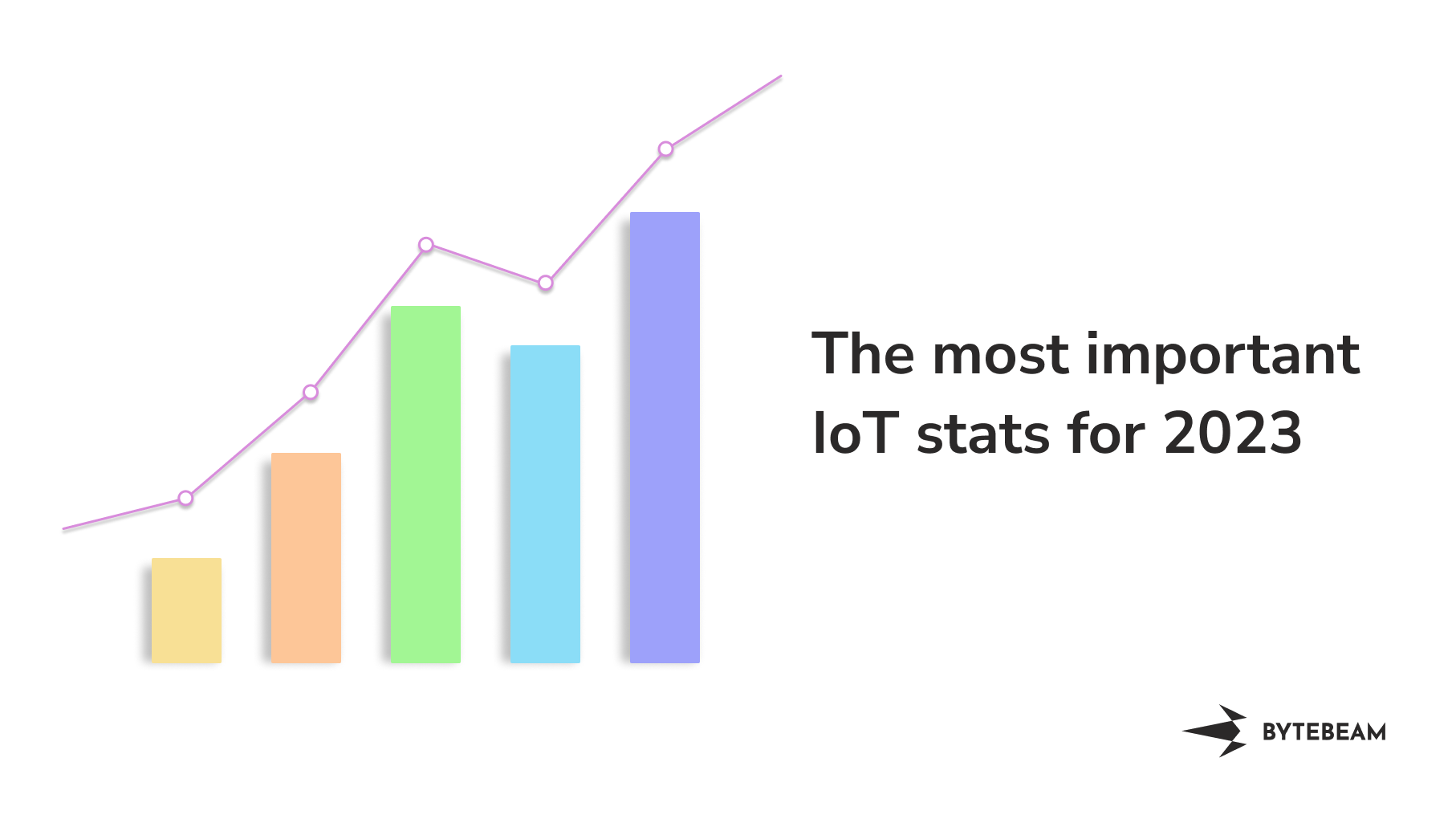The most important IoT stats for 2024

We bid adieu to 2023 on a high, as the global spending on IoT reportedly surpassed USD 1 trillion. As we start off the new year, we are expecting some big changes. But before that happens, let us take a look at what the last year looked like for Internet of Things.
What to expect: In this article, we'll take a look at the most important IoT statistics for 2024. We'll explore the expected growth of the IoT market and the number of devices that will be in use. Also, we will examine the top industries and countries for IoT adoption, as well as the most popular use cases for these devices.
IoT Statistics in 2023
IoT growth continued at a rapid pace in 2023, with over 15.4 billion IoT devices in use. Here are some preliminary facts and stats from the past year:
- The top 5 industries for IoT were healthcare, transportation, energy, manufacturing, and construction.
- The top 5 countries for IoT were the United States, China, Japan, South Korea, and Germany.
- The top 5 use cases for IoT are predictive maintenance, smart cities, connected Healthcare, precision agriculture, and environmental monitoring.
- Supply chain was the most accelerated IoT vertical in 2023, yet again.
- There were approximately 500 publicly disclosed data breaches involving IoT devices in 2023.
- IEEE released several updates to existing IoT standards: For example, updates to IEEE 802.15.4 (Zigbee) and IEEE 802.11ah (Wi-Fi HaLow) aimed to improve performance, security, and power efficiency for low-power IoT devices.
- IETF finalized several RFCs related to IoT protocols: These included protocols for device management, data collection, and secure communication in resource-constrained environments.
- OASIS published updates to key IoT specifications: Updates to OASIS CTT and OASIS SensorThings API aimed to enhance interoperability and facilitate data exchange between different IoT platforms.
Several amazing things happened last year, and more are to follow. IoT devices are becoming increasingly common in every industry and country around the world. This growth is being driven by the benefits that these devices can offer businesses and consumers alike.
In healthcare, for example, IoT devices can be used to track patients' vital signs and provide early warning of potential health problems. In transportation, IoT devices can be used to monitor traffic conditions and optimize routes to reduce travel times.
Important IoT Statistics in 2024
2024 is not just another revolution around the sun, we are looking at some major tech developments across industries. The new standards and developments that are coming up in IoT alone are mind-boggling. So it is amazing to witness the data that promises more.
The global IoT market is expected to reach USD 1,387 billion by this year(2024)
The global IoT market is expected to reach $1387 billion in 2024, according to Statista.
IoT already has a major impact on these industries, with asset tracking, predictive maintenance, condition monitoring, quality control, and supply chain management being just some of the use cases that are benefiting from the technology.
So what does this mean for businesses? If you're not already using IoT technology in your business, now is the time to start investigating how it can benefit you. The potential applications for IoT are almost limitless, so there's sure to be a use case that can help your business improve its efficiency or bottom line.
IoT devices worldwide will cross the 24.4 billion mark this year
IoT devices are expected to cross 24.4 billion this year, which is over a 108% increase from 2020! Additionally, it is expected that these devices will generate 79.4 zettabytes (ZB) of data in 2025. The proliferation of IoT devices has been driven by the falling cost of sensors and connectivity, as well as the increasing processing power of edge devices.
The demand for IoT devices is being driven by the need for better data collection and analysis across industries.
The top 5 industries for IoT are manufacturing, healthcare, transportation, energy, and construction
IoT devices are becoming increasingly prevalent due to their many benefits, with growth expected to continue at a rapid pace in the coming years.
The top 5 industries for IoT are healthcare, transportation, energy, manufacturing, and construction.
The top 5 countries for IoT are the United States, China, Japan, South Korea, and Germany
As of 2024, the United States, China, Japan, South Korea, and Germany will be the top 5 countries for IoT. These countries have the highest number of IoT devices as well as the largest IoT markets. The United States is expected to have the most growth in IoT, followed by China and Japan. South Korea and Germany are expected to see more moderate growth.
The United States has the largest number of IoT devices, with a projected amount of US$199.00bn in 2024. The country also has the largest IoT market, which is expected to reach $1 trillion by 2025. The United States is expected to see strong growth in all industries that adopt IoT devices. However, the healthcare, transportation, and construction industries are expected to be the major contributors to this growth.
China is expected to have the second-largest number of IoT devices. The country's IoT market is expected to reach $847 billion by 2025. China's transportation and manufacturing industries are expected to be the major contributors to its IoT growth.
Japan is expected to have 3.5 billion IoT devices in use by 2024. The country's IoT market is expected to reach $642 billion by 2025. Japan's transportation and healthcare industries are expected to be the major contributors to its IoT growth.
South Korea is expected to have 2.9 billion IoT devices in use by 2024. The country's IoT market is expected to reach $557 billion by 2025. South Korea's transportation and energy industries are expected to be the major contributors to its IoT growth.
Germany is expected to have 2.8 billion IoT devices in use by 2024. The country's IoT market is expected to reach $545 billion by 2025
The top 5 use cases for IoT are asset tracking, predictive maintenance, condition monitoring, quality control, and supply chain management
IoT devices offer a variety of benefits, making them useful for a wide range of applications. Here are the five most important ways that IoT can be used in businesses and organizations:
Predictive Maintenance: Utilizing sensors and data analysis to proactively identify potential equipment failures before they occur, preventing downtime and optimizing maintenance schedules. This application saw widespread adoption in manufacturing, transportation, and energy sectors.
Smart Cities: Integrating various IoT devices and sensors like traffic lights, noise monitors, and air quality sensors into city infrastructure to optimize traffic flow, energy consumption, waste management, and public safety. Cities like Barcelona and Singapore were examples of this trend.
Connected Healthcare: Implementing wearable devices, remote monitoring systems, and smart medication dispensers to improve patient care, enable remote management of chronic conditions, and enhance the efficiency of healthcare services. These innovations were particularly helpful in rural areas and for managing aging populations.
Precision Agriculture: Employing sensors, drones, and data analytics to optimize irrigation, fertilization, and pest control in agriculture, leading to increased yield, reduced water usage, and improved crop quality. This advancement was crucial for sustainable farming practices and food security.
Environmental Monitoring: Deploying sensor networks to monitor air and water quality, track wildlife populations, and detect environmental hazards in real-time. This technology played a vital role in environmental protection, climate change mitigation, and disaster preparedness.
5G will continue to drive the growth of IoT with 5G cellular subscriptions reaching 1.9 billion by 2024.
5G is the next generation of cellular technology, and it will provide faster speeds and lower latency than 4G LTE. This will enable new applications and use cases for IoT, such as connected cars and augmented reality.
5G cellular subscriptions are expected to reach 1.9 billion by 2024, according to a report from Ericsson.
5G will also help to drive the growth of IoT by reducing the cost of connecting devices to the internet and by increasing the battery life of IoT devices.
Over 10% of VC funding is IoT-related
In 2019, $134.6 billion was invested in IoT-related startups. IoT is still one of the most well-funded industries by VCs.
According to Pitchbook, Global IoT startups brought in $2.8 billion in venture funding in Q2—a more than 57% decline from the record first quarter and the lowest deal value since Q4 2019.
The top 5 countries for VC funding for IoT are the United States, China, United Kingdom, India, and Germany. Whereas, the top 5 industries for VC funding for IoT are healthcare, transportation, manufacturing, retail, and energy.
IoT is radically changing the supply chain verticL
The Internet of Things (IoT) is transforming the game by enabling comprehensive tracking and monitoring of every shipment, leading to faster error detection and prevention, and enhanced efficiency and reduced delivery times.
-70% of retailers are actively integrating IoT into their supply chains.
-DHL plans to equip its entire fleet of 10,000 trucks with IoT sensors by 2028, aiming to halve delivery times.
-UPS already utilizes 100,000 IoT tracking devices, generating 60 million data points weekly.
IoT is revolutionizing global supply chains, boosting efficiency, transparency, and overall performance. This technological revolution is changing the game for manufacturers, logistics companies, and ultimately, consumers.
Final Thoughts
Evidently, IoT has been growing at a breakneck speed in the last few years. This growth is expected to continue in 2024 as well.
It is important to consider the effect of a looming recession and a dearth of investments in the coming year, but the overall penetration of the technology is expected to remain the same. Investing in IoT solutions that are cost and time efficient can help you maximize your returns this year.
If you would like to know more about how you can invest smartly in IoT, feel free to reach out to us for a quick chat.

